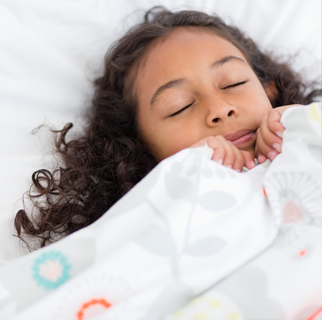What are night terrors?
A night terror is a partial waking from sleep with behaviors such as screaming, kicking, panic, sleep walking, thrashing, or mumbling. They are harmless, and each episode will end in deep sleep. They tend to occur in children between the ages of 4 and 12.
These are common characteristics of a night terror:
-
Your child is frightened but can't be awakened or comforted.
-
Your child's eyes are wide open, but they don't know that you are there.
-
The episode may last up to 45 minutes.
-
Your child often doesn't remember the episode in the morning.
How to help a child during a night terror
-
Try to help your child return to normal sleep. Don't try to awaken your child. Make soothing comments. Hold your child if it seems to help them feel better. Shaking or shouting at them may cause them to become more upset.
-
Protect your child against injury. During a night terror, a child can fall down a stairway, run into a wall, or break a window. Try to gently direct them back to bed.
-
Prepare babysitters for these episodes. Explain to people who care for your child what a night terror is and what to do if one happens.
-
Try to prevent night terrors. A night terror can be triggered if your child becomes overtired. Be sure they go to bed at a regular time, and early enough to give them enough sleep. Younger children may need to return to a daily nap.
When to call your child's healthcare provider
Night terrors are not harmful, but they can look like other conditions or lead to problems for the child. They usually go away by the teenage years. Talk with your child's healthcare provider if you notice any of the following:
-
The child has drooling, jerking, or stiffening
-
Terrors are interrupting sleep on a regular basis
-
Terrors last longer than 30 minutes
-
Your child does something dangerous during an episode
-
Other symptoms happen with the night terrors
-
Your child has daytime fears
-
You feel family stress may be a factor
-
You have other questions or concerns about your child's night terrors
What are nightmares?
Nightmares are scary dreams that awaken children and make them afraid to go back to sleep. Nightmares may happen for no known reason, but they sometimes happen when your child has seen or heard things that upset them. These can be things that actually happen or are make-believe. Nightmares often relate to a child's developmental stages. Toddlers may dream about separation from their parents. Preschoolers may dream about monsters or the dark. School-aged children may dream about death or real dangers. Nightmares are most common between ages 3 and 6. They tend to peak by age 10, but some people have nightmares that continue into adolescence and even adulthood.
How to help a child with nightmares
Here are things you can do to help your child:
-
Comfort, reassure, and cuddle your child.
-
Help your child talk about the bad dreams during the day.
-
Protect your child from seeing or hearing frightening movies and TV shows.
-
Leave the bedroom door open or leave a night light on if it comforts your child. Never close the door on a fearful child.
-
Provide a "security blanket" or toy for comfort.
-
Let your child go back to sleep in their own bed.
-
Don't spend a lot of time searching for "the monster."
-
During the bedtime routine, before your child goes to sleep, talk about happy or fun things.
-
Read some stories to your child about getting over nighttime fears.
When to call your child's healthcare provider
Talk with your child's healthcare provider if you notice any of the following:
-
The nightmares become worse or happen more often
-
The fear interferes with daytime activities
-
You have other concerns or questions about your child's nightmares
Featured in


